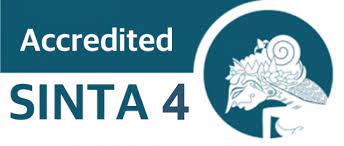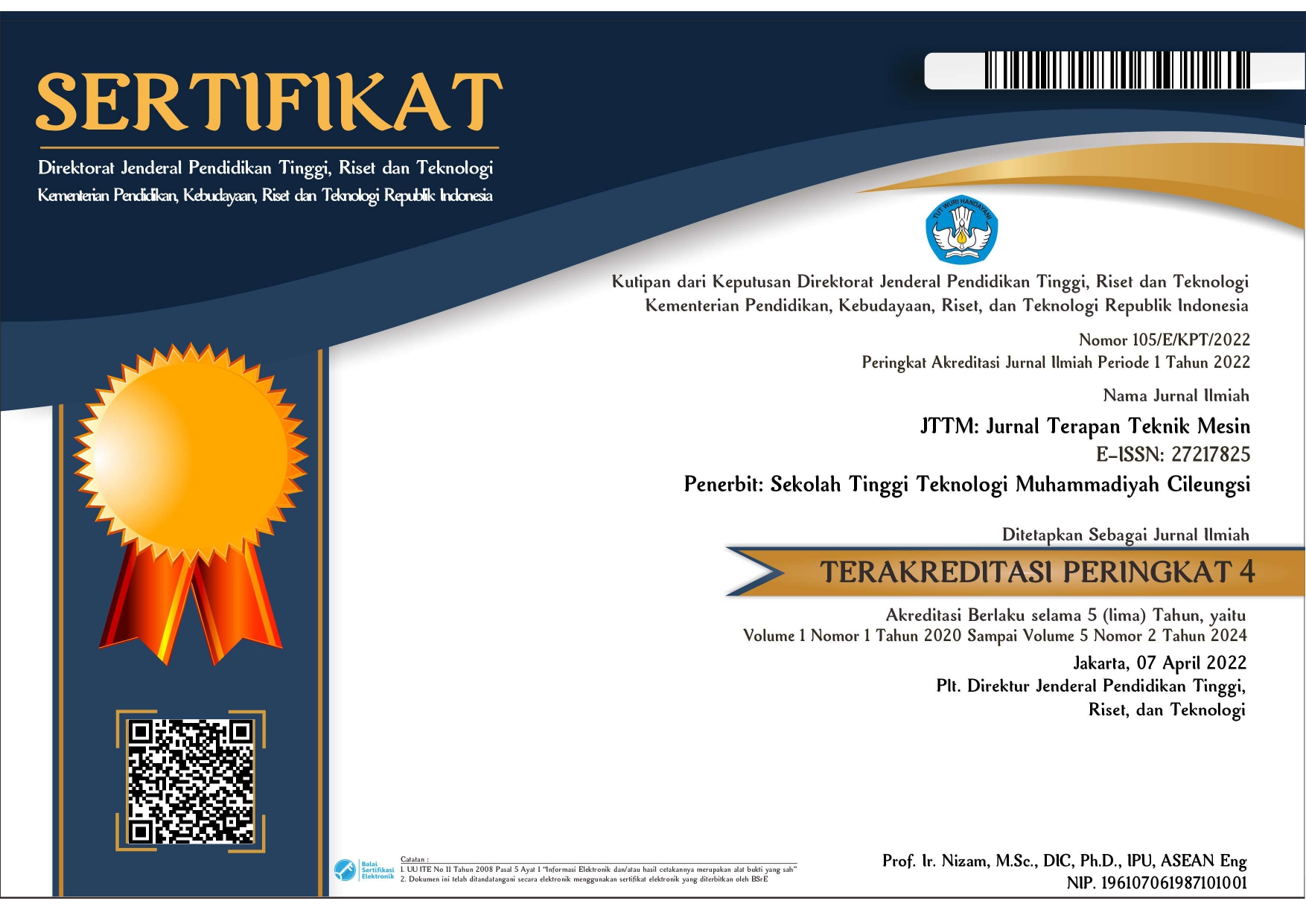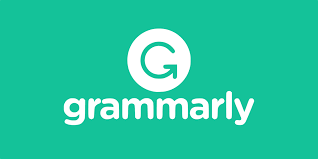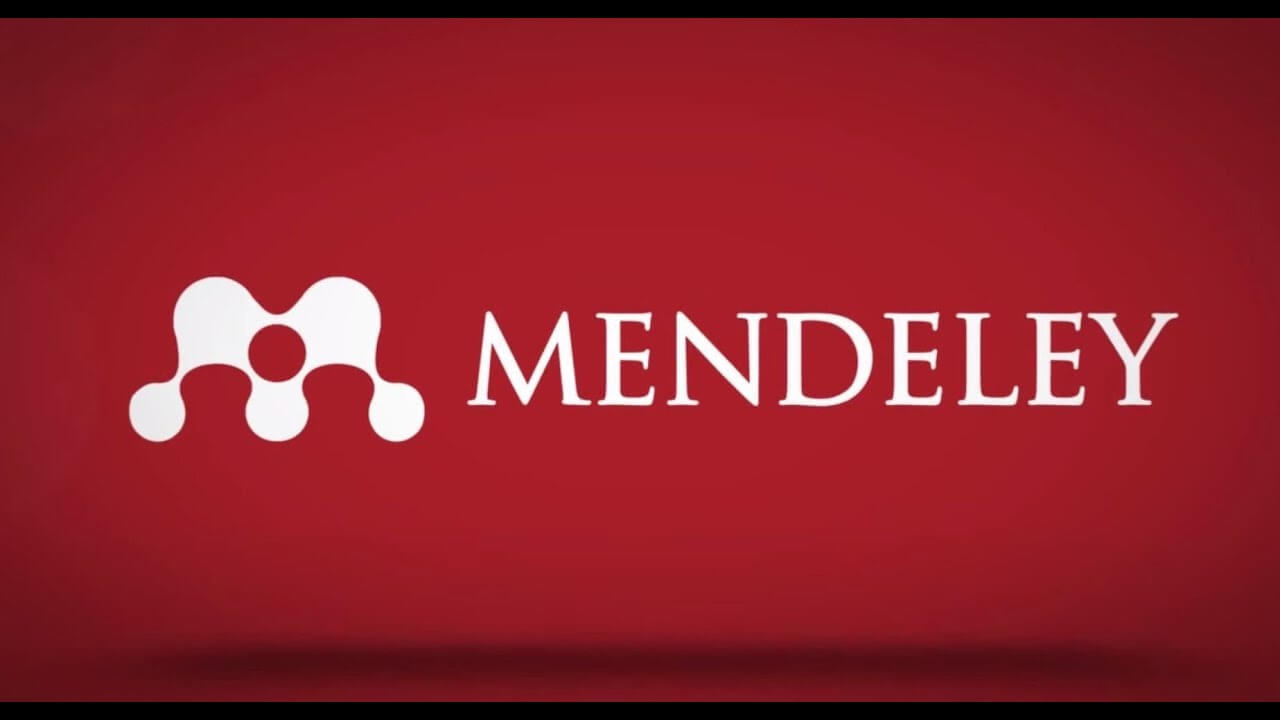Publication Ethics
Statements on Publication Ethics and Publication Malpractice
(Statement on Publication Ethics and Malpractice) based on: COPE
This statement clarifies the ethical behavior of all parties involved in the act of publishing articles in the Journal of Jurnal Terapan Teknik Mesin (JTTM), including authors, editors, peer-reviewers, and publishers of the Research Institute, Community Service, Publication and Cooperation of the Sekolah Tinggi Teknologi Muhammadiyah Cileungsi.
The COPE Best Practice Guidelines for Journal Editors provide the basis for this statement.
1. Journal Publication Ethical Guidelines
Jurnal Terapan Teknik Mesin (JTTM) publishes articles in the field of industrial engineering. Editors accept scientific articles or papers containing research results, literature reviews, or review activities closely related to the field of Industrial Engineering.
The publication of articles in the peer-reviewed Jurnal Terapan Teknik Mesin (JTTM) is important in the development of a coherent and respected knowledge network. This is a direct reflection of the quality of the work of the authors and the institutions that support them. The peer-reviewed articles support and embody the scientific method. It is therefore important to agree on standards of expected ethical behavior for all parties involved in the act of publishing: authors, journal editors, peer reviewers, publishers, and the public.
LPPMPK, Sekolah Tinggi Teknologi Muhammadiyah Cileungsi, as publisher Jurnal Terapan Teknik Mesin (JTTM) perform their duties as trustees at all stages of the publishing process and we are aware of our ethical and other responsibilities.
We are committed to ensuring that advertising, reprint or other commercial revenue does not have an impact or influence on editorial decisions, Other than that, Department of Industrial Engineering, Faculty of Engineering, Sekolah Tinggi Teknologi Muhammadiyah Cileungsi, Indonesia. and the Editorial Board will assist in communication with other journals and/or publishers where this is useful and necessary
The Writer's Job
1. Reporting Standars
Authors of the original research report must present an accurate account of the work done as well as an objective discussion of its significance. The underlying data must be represented accurately in the paper. A paper must contain sufficient details and references to allow others to replicate the work. False or intentionally inaccurate statements constitute unethical behavior and are unacceptable. Professional publication reviews and articles must also be accurate and objective, and editorial 'opinion' works must be clearly identified
2. Access to and storage of data
Authors may be required to provide raw data with respect to a paper for editorial review, and in any case, should be prepared to retain such data for a reasonable time after publication.
3. Originality and plagiarism
- The authors must ensure that they have written the entirely original work, and if the author has used the work and/or words of others, that this has been properly cited or cited.
- Plagiarism takes many forms, from 'passing' someone else's paper as the author's own, to copying or paraphrasing important parts of another's paper (without attribution), to claiming results from research done by others.
- Plagiarism in all its forms constitutes unethical publishing behavior and is unacceptable.
4. Multiple Publications
- An author may not generally publish manuscripts describing essentially the same research in more than one journal or major publication.
- Submitting the same manuscript to more than one journal at the same time constitutes unethical publishing behavior and is unacceptable.
- In general, authors should not submit to other journals previously published papers for consideration.
5. Source Acknowledgment
- Proper acknowledgment of the work of others must always be given.
- Authors should cite publications that were influential in determining the nature of the reported work.
- Information obtained personally, such as in conversations, correspondence, or discussions with third parties, may not be used or reported without the written permission of the source.
- Information obtained in the course of confidential services, such as reference manuscripts or grant applications, may not be used without written permission from the authors of the works involved in these services.
6. Second, Third Author.
- Authorship should be limited to those who have made a significant contribution to the conception, design, conduct, or interpretation of the reported research.
- All who have made significant contributions must be listed as co-authors.
- Where there are others who have participated in certain substantive aspects of the research project, they must be recognized or listed as contributors.
- Appropriate authors must ensure that all co-authors have seen and approved the final version of this paper and have approved its submission for publication.
7. Hazards and human or animal subjects
If the work involves the use of animal or human subjects, all procedures were carried out in accordance with relevant laws and institutional guidelines. The right to privacy of human subjects must always be considered by the authors. If the work involved unusual chemicals, procedures, or equipment that have unusual hazards, clearly identify these in the manuscript.
8. Disclosure and Conflict of Interest
All authors must disclose in their manuscripts any financial or other substantive conflicts of interest that may influence the results or interpretation of their manuscripts. All sources of financial support for the project must be disclosed, including employment, consulting, shareholding, honoraria, paid expert testimony, patent applications/registrations.
9. Fundamental errors in published works
Author must immediately retract or correct self-published work if he finds significant errors or inaccuracies. Author must provide evidence to the editor of the correctness of the original paper. If a third party discovers significant errors, it is the obligation of the author to correct the paper.
Editor's Task
1. Publication decision
- Editors of peer-reviewed journals (peer reviewers) are responsible for deciding which of the articles submitted to the journal should be published, often working in conjunction with the concerned community (for community-owned or sponsored journals).
- The validation of the work in question and its importance to researchers and readers should always drive such decisions.
- Editors may be guided by the discretion of the journal's editorial board and limited by applicable legal requirements regarding defamation, copyright infringement, and plagiarism.
- The editor may confer with other editors or reviewers (or public officials) in making this decision
2. Fair In Publication
Editors must evaluate manuscripts for their intellectual content without regard to race, gender, sexual orientation, religious beliefs, ethnic origin, nationality, or political philosophy of the authors.
3. Confidentiality
Editors and any editorial staff may not disclose any information about submitted manuscripts to anyone other than the appropriate authors, reviewers, prospective reviewers, other editorial advisors and publishers, as appropriate.
4. Disclosure and conflicts of interest
- Unpublished material disclosed in submitted manuscripts may not be used in the editor's own research without the written consent of the author.
- Privileged information or ideas obtained through peer review must be kept confidential and not used for personal gain.
- Editors must withdraw (e.g. must request co-editors, associate editors or other members of the editorial board to review and consider) from considering manuscripts in which they have a conflict of interest caused by competition, collaboration, or other relationship or relationship with any of the authors, companies, or (possibly) institutions connected to newspapers.
- Editors must require all contributors to disclose relevant competing interests and issue corrections if competing interests are expressed after publication.
- If necessary, other appropriate action should be taken, such as the publication of a retraction or the expression of a concern.
Reviewer Task
1. Contribute to editorial decisions
Peer review reviews are an important component of formal scientific communication and are at the core of the scientific method. Peer reviews assist editors in making editorial decisions and through editorial communication with authors can also assist authors in improving papers.
2. Accuracy
Any selected referee who feels unqualified to review the research reported in a manuscript or knows that a rapid review is not possible should notify the editor and excuse himself from the review process.
3. Confidentiality
Any manuscript received for review must be treated as a confidential document. They may not be shown or discussed with others except as permitted by the editor.
5. Objectivity Standards
Referees must express their views clearly with supporting arguments. Personal criticism of the author is inappropriate according to the 's chief refereeing officer. The review must be carried out objectively and impartially he said.
6. Source Acknowledgment
Reviewers should identify relevant published work that has not been cited by the authors. Any statement that an observation, derivation, or argument has been previously reported must be accompanied by a relevant citation. The viewer should also draw the attention of the editor to the substantial similarities or overlaps between the manuscript under consideration and other published papers of personal knowledge.
7. Disclosure and conflicts of interest
Reviewers should not consider manuscripts in which they have a conflict of interest arising from competition, collaboration, or any other relationship with the author, company, or institution to which the paper is connected. Privileged information or ideas obtained through peer review must be kept confidential and not used for personal gain.
Editor in chief
1. Notes
The has a strict policy against plagiarism. Plagiarism is checked through two methods: reviewer checks and plagiarism prevention tools. The submission must not have been previously published, nor must it be under consideration for publication elsewhere. It must not be considered for publication in the future.
2. Source
Recommended by Elsevier and COPE Best Practice Guidelines for Journal Editors










